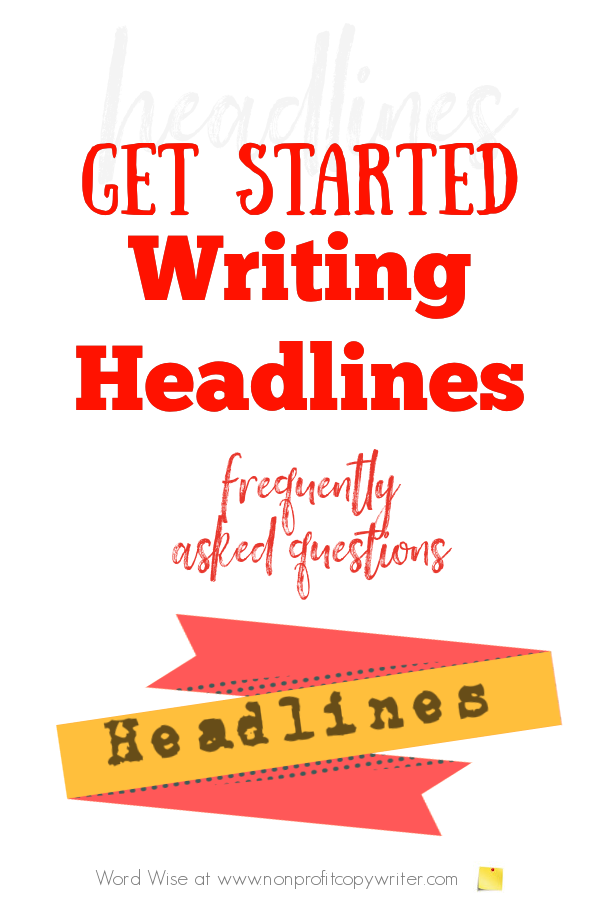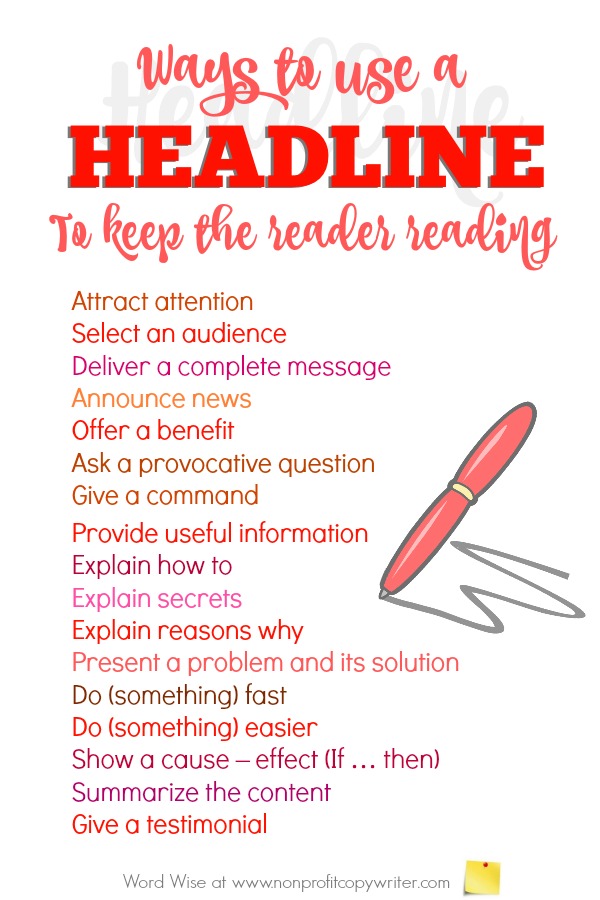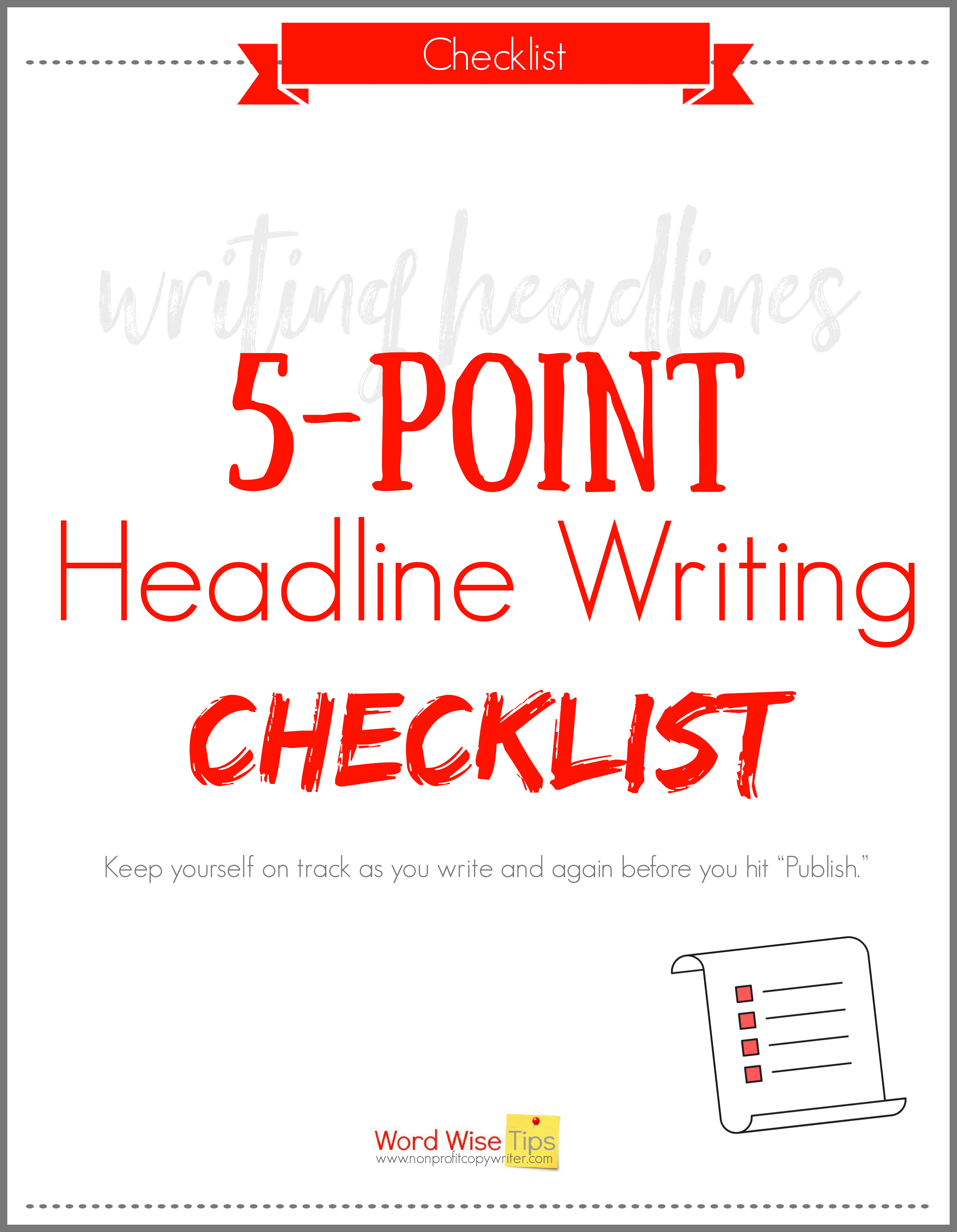Save Time: Get 5 Simple Writing Tips
you can put to use in 10 minutes
Basics for Copywriting Headlines: FAQs for Getting the Click
Award-winning writer Kathy Widenhouse has helped hundreds of nonprofits and writers produce successful content , with 750K+ views for her writing tutorials. She is the author of 9 books. See more of Kathy’s content here.
Updated 2.13.25
While every writing task is important, copywriting headlines is crucial. A headline is your introduction, first impression, opening line, and sales pitch all rolled into one.
That’s plenty intimidating. But never fear! Here you’ll find plenty of practical information to help you learn to write compelling headlines including …
- How headlines work to impact the reader
- Headline mechanics
- Kinds of headlines and headline formulas
- Headline do's and don'ts
Copywriting headlines – and doing it well – simply takes a bit of common sense and a decent amount of practice. But first things first.
Q. What is a headline?
A headline is text that introduces the subject matter of the piece. It can take different forms. A headline is known as a title (above an article), a subject line (for an e-mail), a banner (on a newsletter), teaser (on an outer envelope), a Johnson box (on a direct mail letter), or even a caption (below a photo).
Q. Why are headlines so important?
Eight out of 10 people read headlines. Just 2 out of 10 read the rest of the piece. Those who actually read your headline will decide within an estimated 5 – 10 seconds whether or not to continue. The headline is the first entry point to your article, web page, or email campaign. If the reader stops at the headline, your piece will not get read. That’s why the headline plays an especially crucial role in any piece.
Q. What does a headline do?
Every element of a compelling piece has just one purpose – to get the next sentence read, culminating in the call to action. (Obviously, the call to action’s job is to get the reader to take a specific action.)
It follows then that headline’s singular most important function is to draw the reader into the piece and keep reading.
Q. How can I write a headline so it grabs attention?
The top ways to grab a reader’s attention with a headline are:
- Use strong
action verbs
Example: "Create better headlines from scratch" - Include numbers
in your headline
Example: "Write better headlines with these 5 tips" - Address your
reader’s emotional triggers, like fear and greed
Example: "Write better headlines – or readers will pass over your content "[fear] - Offer a benefit
Example: "Write better headlines quickly and easily with these 5 tips" - Write clearly
Example: "Write better headlines now" [just 4 words]
Q. What are some ways a headline can convince my reader to keep reading?
These methods are the most commonly used by writers use to create engaging headlines.
- Attract attention
- Select an audience
- Deliver a complete message
- Announce news
- Offer a benefit
- Ask a provocative question
- Give a command
- Provide useful information
- Explain how to
- Explain secrets
- Explain reasons why
- Present a problem and its solution
- Do (something) fast
- Do (something) easier
- Show a cause – effect (If … then)
- Summarize the content
- Give a testimonial
Q. Should I capitalize the headline?
The first word in a headline is always capitalized. Beyond that, follow the writer’s guidelines for the specific publication or client.
Q. How long should a headline be?
That depends.
- Article headlines are typically short – 3-6 words or less.
- Email subject lines vary in their optimal length between 27 to 77 characters depending on which kind of device is used to view them, but those subject lines with 35 characters or less get the best open rates.
- Web page meta titles – the text that appears on the browser header – should be 90 – 150 characters. (Various browsers allow different lengths.)
- Social media posts with 70 characters or less receive the highest number of shares. And they don’t get cut off from the viewer.
Experts weigh in:
- Copywriter Ted Nicholas (Mr. 17-Times-The-Sales) asserts that a headline should never be longer than 17 words.
- Marketing guru Dan Kennedy endorses long headlines for long direct response copy.
Bottom line: headline length is closely associated with the type of piece for which it’s written. A headline should be as long as it needs to be to get the specific job done for that particular type of content.
Q. Should I write the headline before or after the rest of the piece?
Some writers swear that writing the headline first keeps the main idea of the piece front and center and allows them to stay on task.
Others write their content first and later summarize it with the headline.
Still others write out the piece’s main idea, write the piece, and then decide if the main idea serves as the headline.
Try each approach to copywriting headlines and go with what works for you.
Q. What’s the difference between a headline and a title?
“Titles” are used for substantial projects like books or research papers. “Headlines” are used for articles or blog posts and need to be attention-grabbing, concise, and targeted to specific audiences. The principles for producing both are similar.
Q. What
about online headlines – do I write a headline for a blog post the same way I
write one for a social media post?
General headline principles remain the same across genres but differ slightly between content types. Headlines for social media, for example, are punchier in order to elicit interaction. Blog headlines are more descriptive and benefit oriented, designed to move the reader to read the post.
Q. Should I
use a question in my headline?
Yes, but be forewarned: question headlines can be powerful – but tricky.
To be effective they must meet certain criteria.A question in the headline implies there’s a solution in the content. Question headlines work when they are open-ended and when you content provides the answer.
On the other hand, question headlines fail when they don’t do their job. That is, they can be answered without the user reading the content … they can be answered with a Yes or No … or your content doesn’t provide a satisfactory answer.
Q. Are puns and humor effective in headlines?
Not often. They’re confusing and lack clarity. People scan headlines and then decide to click. They don’t want to think too hard in the process and if forced to do so, will simply move onto something else. Puns require a bit too much brain power and lack specificity For instance …
Want to be well-red or well-read?
From reading the headline, you can’t tell if the product is for sunscreen or a powerful literacy tool.
Q. How useful is alliteration in copywriting headlines?
Alliteration is a writing device. It’s a repeated consonant sound in two or more words, like “Peter Piper picked a peck of pickled peppers.” Or, more simply, “Kids count.” Alliteration can make headlines more memorable, engaging, and rhythmic, which can help grab a reader’s attention.
- Repeated sounds
make headlines easier to recall.
Example: "Tasty Tomato Tips for Thriving Gardens" - Rhythmic
headlines are pleasant to the ear.
Example: "Savvy Strategies for Successful Sales" - Catchy sounds
stand out in a sea of content.
Example: "Boost Your Brand with Bold Blogging"
Tip: overusing alliteration can make headlines feel forced or gimmicky. The key is to use alliteration naturally and strategically. If you create a headline that uses alliteration and it doesn’t sound like a 13-year-old’s essay paper title, then proceed.
Q. Should I include keywords in my headline for SEO?
Yes, especially if your goal is to improve a page’s SEO rankings. In fact, your headline (or page title) is one of the 6 places you should use keywords to maximize your page’s rankings. But a word of caution: always write a headline that appeals first to your human readers, with search engines in second place of priority.
Q. Should I use bold, italicized, or underlined fonts in my headline?
Formatting tools add emphasis. They are a design choice. They same goes for ALL CAPS and exclamation points.
Best advice: don’t use them unless absolutely necessary. Readers have become hardened to visual “screaming.” Instead, use your headline to offer value to your reader. You’ll increase engagement … and gain your reader’s respect, too.
Q. Is it
okay to write clickbait headlines to build traffic?
Clickbait headlines use sensationalized, misleading, or exaggerated language designed to get the reader to click. Clickbait normalizes words like “amazing,” “life-changing,” “shocking,” and “unbelievable.” You’d think that clickbait headlines would get respect. They achieve the desired result: traffic. Any self-respecting blogger or digital content writer wants to get clicks to a website.
But while emotional language can be powerful, it should be used carefully to avoid sounding overhyped or calculating.
Clickbait headlines lure readers into wasting their time. At its core, it’s a manipulative tool and last resort for writers who produce content that has little consequence.
If you invest in creating high quality content, it follows that your headlines will offer value to the reader, too. While it might work in the short term, clickbait often leads to a negative user experience and can damage your reputation as a writer.
Q. Should I
include a call to action in my headline?
“Download Now” or “Learn More” -- and other call to action phrases -- can move your reader to keep reading. If that language works for the content that follows, use it.
Q. Should I
use numbers in headlines?
A number gives a clear expectation of what readers can expect to get in the content that follows. Use a number in a headline and you have a ready-made outline to follow, such as “Use this 5-Point Checklist to Write Better Headlines.”
But a word of caution: it can be tempting use numbers in headlines as a writing crutch. A headline is only as good as the benefit it offers. Make sure your headline includes a gain or advantage for your reader. The number helps enhance that benefit.
How can you know whether or not your numbers add genuine value to your headline? Here’s a useful self-check. Remove the number from the headline. Does the headline still offer a benefit to your reader? If you can honestly answer yes, then your number headline is on the right track.
Q. What should
I know about writing a How-To headline?
How-to headlines make a promise that’s crystal clear. You guarantee the reader a specific result simply when he reads the content that follows.
Their practicality makes how-to headlines popular both with writers and readers. And that’s a problem. Everybody uses them.
Make your how-to headline stand out by offering an additional benefit for your reader. For instance, instead of writing “How To Make a Pie Crust,” try, “How to Make a Pie Crust in Less than 10 Minutes.” Then, be sure your content delivers on your extra benefit’s promise.
Get your free copy and start writing better headlines right away.
Q. How do I know if my headline is effective?
Writers often wonder how to measure whether a headline is working. You can test your headline several ways.
- Run your headline through a checklist before publishing. A self-check is an important step in the writing process..
- Use analytics. How many readers click through to absorb your entire piece of content? How many readers engage by commenting, liking, subscribing, or following?
- Testing. Try different versions of headlines with different segments of your readership (A/B testing) to give you a clear indication of what works best.
Q. What’s one top tip for copywriting headlines?
When I feel myself getting wrapped up in the headline-writing-rule-following frenzy – or if I simply want to assess my headline’s readability – I call upon digital marketer Ian Lurie’s simple tactic: The Blank Sheet of Paper Test. The test is actually just one question for you to answer about your draft headline:
If you wrote your headline on a blank piece of paper and showed it to a stranger, would she understand it?
If you can honestly answer yes, then you’re well on your way to writing a better headline for your content.
More Tips for Writing Headlines
Writing Better Headlines: Simple As 3 + 3 ...
Write Great Headlines With One Simple Formula ...
How to Write How-To Headlines That Pull in More Readers ...
When Do Question Headlines Work?
Top 12 Headline Templates and Why They Work ...
The Problem with Clickbait Headlines (and how to solve it) ...
7 Tips for Using Numbers in Headlines ...
Write a Better Headline When You Answer One Simple Question ...
The 9 Most Surprising Places You Need a Powerful Headline ...
Top copywriting headlines tips: getting started, headline mechanics ...
10 words to use when writing headlines ...
Does your headline do its job?
5-point checklist to use when you write a headline ...
The SELWAB Formula: great for writing leads and headlines ...
Try these 5 proven headline formulas ...
How to Redeem a Bad Headline (So Readers Keep Reading) ...
6 secrets of effective subheads ...
The 4 U's: use this checklist for writing powerful headlines ...
See more tips on our Writing Headlines Pinterest board...
Return from Basics about Copywriting Headlines
to Nonprofit Copywriter home
As an Amazon Associate I earn from qualifying purchases.
Share This Page

Named to 2022 Writer's Digest list
BEST GENRE/NICHE WRITING WEBSITE


Stop Wasting Time!
Grab your exclusive FREE guide, "5 Simple Writing Tips You Can Put to Use in 10 Minutes or Less"














